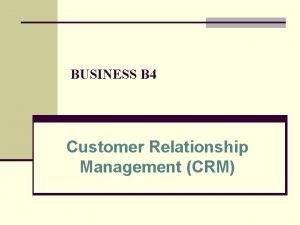Definitions for Project Time Covers all aspects of












- Slides: 12

Definitions for Project Time – ü Covers all aspects of time and duration, from how long it takes to complete one activity right through to the timeframe for the entire project Project Schedule ü Comprises the planned dates for performing project activities, completing deliverables and meeting milestones ü Normally represented as a GANTT chart using MS Project or a similar project scheduling tool Project Time Management – ü The processes required to manage the timely completion of a project Adapated from PMBOK 4 th Edition BSBPMG 503 A Manage Project Time

What is a GANTT chart? • Gantt charts are named after their creator, an American engineer Henry Laurence Gantt, who created the first bar charts in the early 1910’s. • It converts the Work Breakdown Structure into a graphical display of a project schedule • It displays the durations of all scheduled activities including the interdependencies • Often also includes information on project milestones and resource allocation to activities • It has become one of the most widespread project management tools due to the prevalence of MS project BSBPMG 503 A Manage Project Time

Sample GANTT Charts BSBPMG 503 A Manage Project Time

What is a PERT chart? • PERT stands for Programme Evaluation and Review Technique • It was created by a Naval scientist, Frederick Taylor, in the 1950’s • It is a project management technique for determining how much time a project needs before it can be completed. • Each activity is assigned a best, worst and most probable completion time estimate. • These estimates are then used to determine the average completion time and are represented graphically in a network diagram BSBPMG 503 A Manage Project Time

Sample PERT Charts BSBPMG 503 A Manage Project Time

What is a Critical Path? • Was developed in the 1950 s by the Dupont Corporation • The Critical Path Method, abbreviated CPM, or Critical Path Analysis, is a mathematically based algorithm for scheduling a set of project activities. • It takes the activities in the Work Breakdown Structure, the durations and the interdependencies, and calculates the longest path through the project. • It is the longest total duration of all the activities required to complete a project BSBPMG 503 A Manage Project Time

Importance of Time • Project Managers often cite delivering projects on time as one of their biggest challenges. • Schedule issues are one of the main reason for conflicts on projects. • There will be constant pressure from your Project Sponsor and other stakeholders to accelerate delivery • In the relationship between Scope, Time, Cost and Quality, Time normally has the least Scope amount of flexibility Cost BSBPMG 503 A Manage Project Time Quality

Staying on Schedule To stay on schedule, Project Managers must – ü Diligently control Project Scope ü Re-baseline the project schedule after any Change Requests are approved ü Closely monitor the Critical Path activities ü Urgently resolve or escalate risks and issues that relate to activities on the Critical Path ü Renegotiate the baseline Project Schedule whenever it changes due to external factors ü Manage stakeholder expectations closely ü Evaluate performance against the agreed and re-baselined Project Schedule BSBPMG 503 A Manage Project Time

An Analogy • Staying on schedule is like piloting a plane that is on auto pilot • You will always get from point A to point B but at any point in time you are Most direct route normally off course • You need to constantly correct your course Point A BSBPMG 503 A Manage Project Time Point B Critical Path given weather and other air traffic

Characteristics of Project Time • Project timeframes are one of the primary sources of conflict on projects • Timeframes are often artificially imposed on projects due to other factors such as business plan cycles, sales targets, performance objectives etc • Project timeframes are hard to predict when there is high risk Refined during the project High level becoming detailed BSBPMG 503 A Manage Project Time Assumptions often Constraints required will be applied Changes need to be monitored Measures project success

Project Time Interrelationships • Time is one of the “triple constraints” to Project Scope Time • Normally the least flexible • Often imposed on the project based business priorities and other dependencies Cost Quality • When the timeframe is fixed then Scope and Quality will need to be sacrificed when additional time is required due to invalid assumptions, missed deadlines or additional effort • High Risk projects normally exceed original timeframes! BSBPMG 503 A Manage Project Time

Project Time Processes • PMBOK Project Time Management Processes ü 6. 1 Define Activities ü 6. 2 Sequence Activities ü 6. 3 Estimate Activity Resources ü 6. 4 Estimate Activity Duration ü 6. 5 Develop Schedule ü 6. 6 Control Schedule • Related processes from Project Integration Management – ü 4. 1 Develop Project Charter ü 4. 2 Develop Project Management Plan BSBPMG 503 A Manage Project Time
 All aspects of software production
All aspects of software production All aspects of the organization's physical facility
All aspects of the organization's physical facility Involves managing all aspects of a customer relationship
Involves managing all aspects of a customer relationship Name three line segments
Name three line segments Aspek manajemen proyek
Aspek manajemen proyek Alterations in various aspects of society over time
Alterations in various aspects of society over time Example of elapsed time
Example of elapsed time Kontinuitetshantering i praktiken
Kontinuitetshantering i praktiken Typiska drag för en novell
Typiska drag för en novell Nationell inriktning för artificiell intelligens
Nationell inriktning för artificiell intelligens Returpilarna
Returpilarna Varför kallas perioden 1918-1939 för mellankrigstiden
Varför kallas perioden 1918-1939 för mellankrigstiden En lathund för arbete med kontinuitetshantering
En lathund för arbete med kontinuitetshantering























